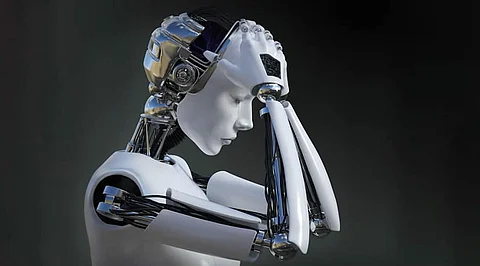

A most helpful aspect of robots is that they don't feel pain. Along these lines, we have no issue giving them something to do in dangerous conditions or having them perform tasks that range between marginally unpleasant and definitely fatal to a human. However, this is a thing of the past.
A group of researchers from Osaka college in Japan have built up a sharp edge runner-esque robot that can 'feel pain. The robot is built in such a way that it can wince when an electric charge is applied to its skin, in plans to teach empathy to artificial intelligence.
The group embedded an artificial pain system introduced through the type of 'affetto', a hyper-realistic child robot made by engineers in 2018. With the essence of a little child, the robot can make realistic-looking facial expressions, responding to touches by smiling, frowning and grimacing.
To make affetto, analysts recognized 116 diverse facial points, and examined the systems expected to make distinctive expressions. Presently they need to empower it to deal with pain. Lead researcher professor Minoru Asada, who is likewise President of the Robotics Society of Japan, trusts that thus, machines may be able to feel compassion and profound morality.
Another milestone, Researchers from Nanyang Technological University in Singapore have published a paper to Nature Communications recording their framework that takes into account robots to have artificial intelligence (AI) to perceive pain and to self-fix when harmed.
This is accomplished utilizing AI-empowered sensor nodes to process and respond to 'pain' emerging from pressure applied by a physical force. Joined with a self-mending ion gel material, the framework likewise empowers the robot to distinguish and fix harm without the requirement for human intercession.
The majority of the world's present robots get data about their immediate environmental factors through a network of sensors. Nonetheless, these sensors don't deal with data, yet rather send the data to a central processing unit. This central processing unit is the place where learning happens, and it implies current robots are needed to have numerous wires. This framework brings about longer response times.
Other than longer response times, these robots are often effectively harmed and require a ton of maintenance and fix.
In the new framework created by the researchers, the AI is implanted into the network of sensor nodes. There are numerous smaller and less-incredible processing units, which the sensor nodes are associated with. This arrangement permits learning how to place locally, which lessens the number of wires required and response time. In particular, it is diminished five to ten times compared to conventional robots.
To show the robot how to feel pain, the group depended on memtransistors, which go about as 'mind like' electronic gadgets. These gadgets can have memory and data processing, going acting as artificial pain receptors and synapses.
The research showed how the robot could continue reacting to pressure even after it had been harmed. Following an 'injury, for example, a cut, the robot loses mechanical capacity. That is the point at which self-healing ion gel kicks in and makes the robot mend the 'injury,' fundamentally sewing it together.
Partner Professor Arindam Basu is the Co-lead creator of the study. He originates from the School of Electrical and Electronic Engineering.
"For robots to cooperate with people one day, one concern is the manner by which to guarantee they will interface securely with us. Therefore, researchers around the globe have been discovering approaches to carry a sense of awareness to robots, for example, being able to 'feel' pain, to respond to it, and to withstand brutal operating conditions. In any case, the intricacy of assembling the huge number of sensors required and the resultant delicacy of such a framework is a significant barrier for broad adoption."
Join our WhatsApp Channel to get the latest news, exclusives and videos on WhatsApp
_____________
Disclaimer: Analytics Insight does not provide financial advice or guidance. Also note that the cryptocurrencies mentioned/listed on the website could potentially be scams, i.e. designed to induce you to invest financial resources that may be lost forever and not be recoverable once investments are made. You are responsible for conducting your own research (DYOR) before making any investments. Read more here.
